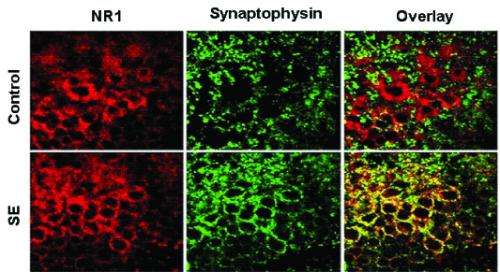Photos depict NMDA receptors moving to the neuron surface during status epilepticus (SE), persistent seizures. The NMDA receptors are in red (NR1), and the cell surface marker is in green (synaptophysin). When they are at the same location (cell surface), the overlap of red and green becomes yellow. The existence of more yellow with SE suggests many more surface NMDA receptors, which can serve as targets for new medication. Credit: Dr. David E. Nayor
In a promising finding for epileptic patients suffering from persistent seizures known as status epilepticus, researchers reported today that new medication could help halt these devastating seizures. To do so, it would have to work directly to antagonize NMDA receptors, the predominant molecular device for controlling synaptic activity and memory function in the brain.
"Despite the development of new medications to prevent seizures, status epilepticus remains a life-threatening condition that can cause extensive brain damage in the patients that survive these persistent seizures," said David E. Naylor, MD, PhD, a lead researcher at the Los Angeles Biomedical Research Institute at Harbor-UCLA Medical Center (LA BioMed) and corresponding author of the new study. "Our research holds promise for the development of new therapies to treat this devastating condition because we have found a potential new target for medical intervention that should bolster the current standard therapies to treat the acute seizures. It may also prevent the long-term adverse effects of persistent seizure activity on the brain."
The research, reported online in the Neurology of Disease journal, used animal models to assess cellular activity in the brain during persistent seizures. It found that the seizure activity seemed to force the NMDA receptors from the interior to the surface of nerve cells causing their activity to increase by approximately 38%.
"The increased presence of the NMDA receptors on the cell surface during these seizures may explain the successful use of NMDA antagonists – medication that inhibits the activity of the NMDA receptors in the brain – in the latter stages of a seizure, long after other medications have stopped working," said Dr. Naylor. "We concluded that medications that suppress the activity of the NMDA receptors, in conjunction with other medications, may be successful in stopping persistent seizures. Further research is, of course, needed."
More information: www.sciencedirect.com/science/ … ii/S0969996113000065


















